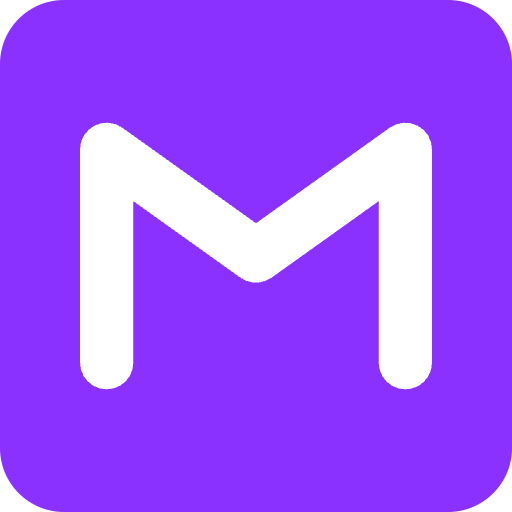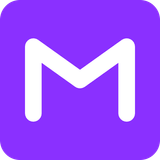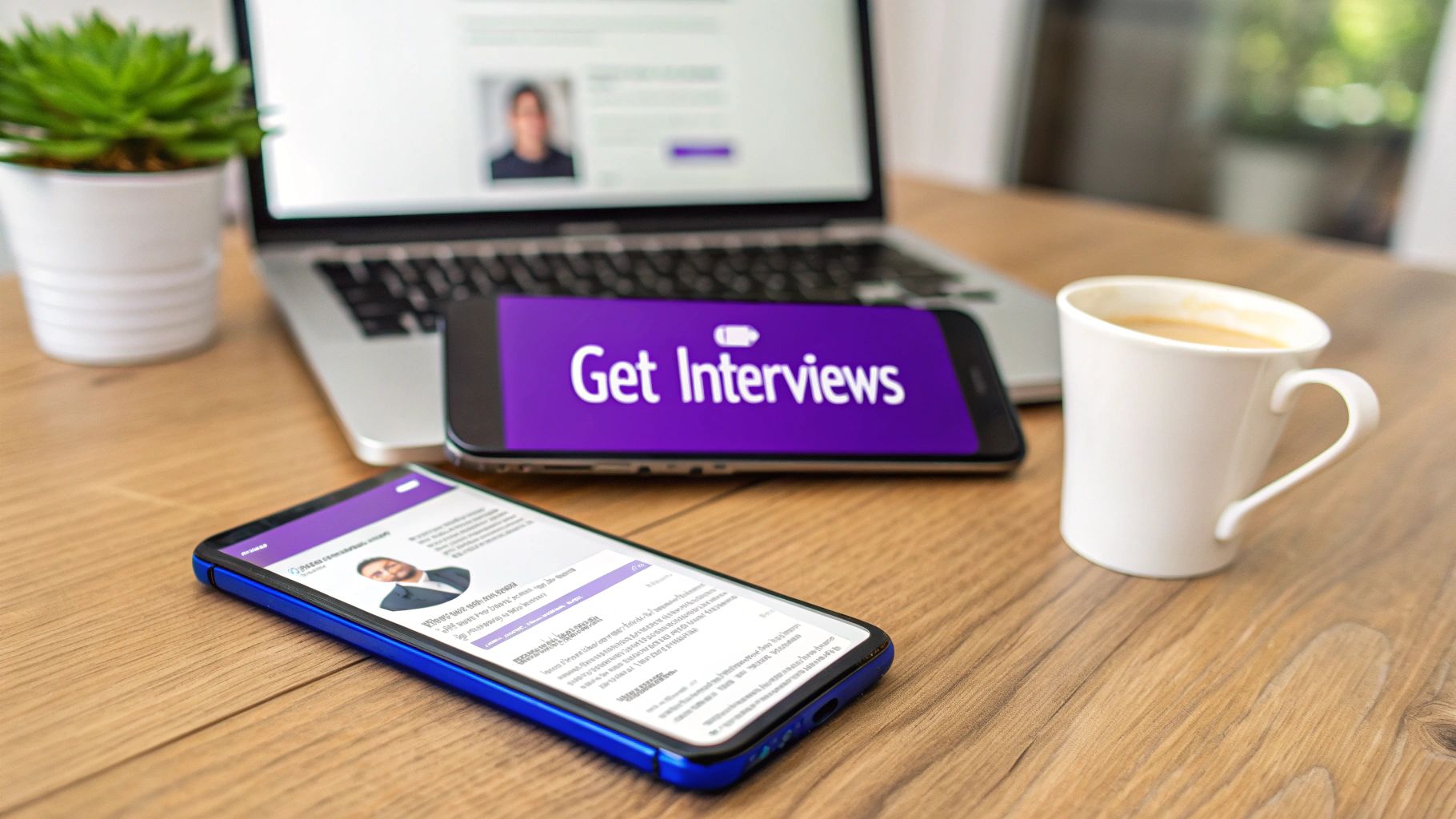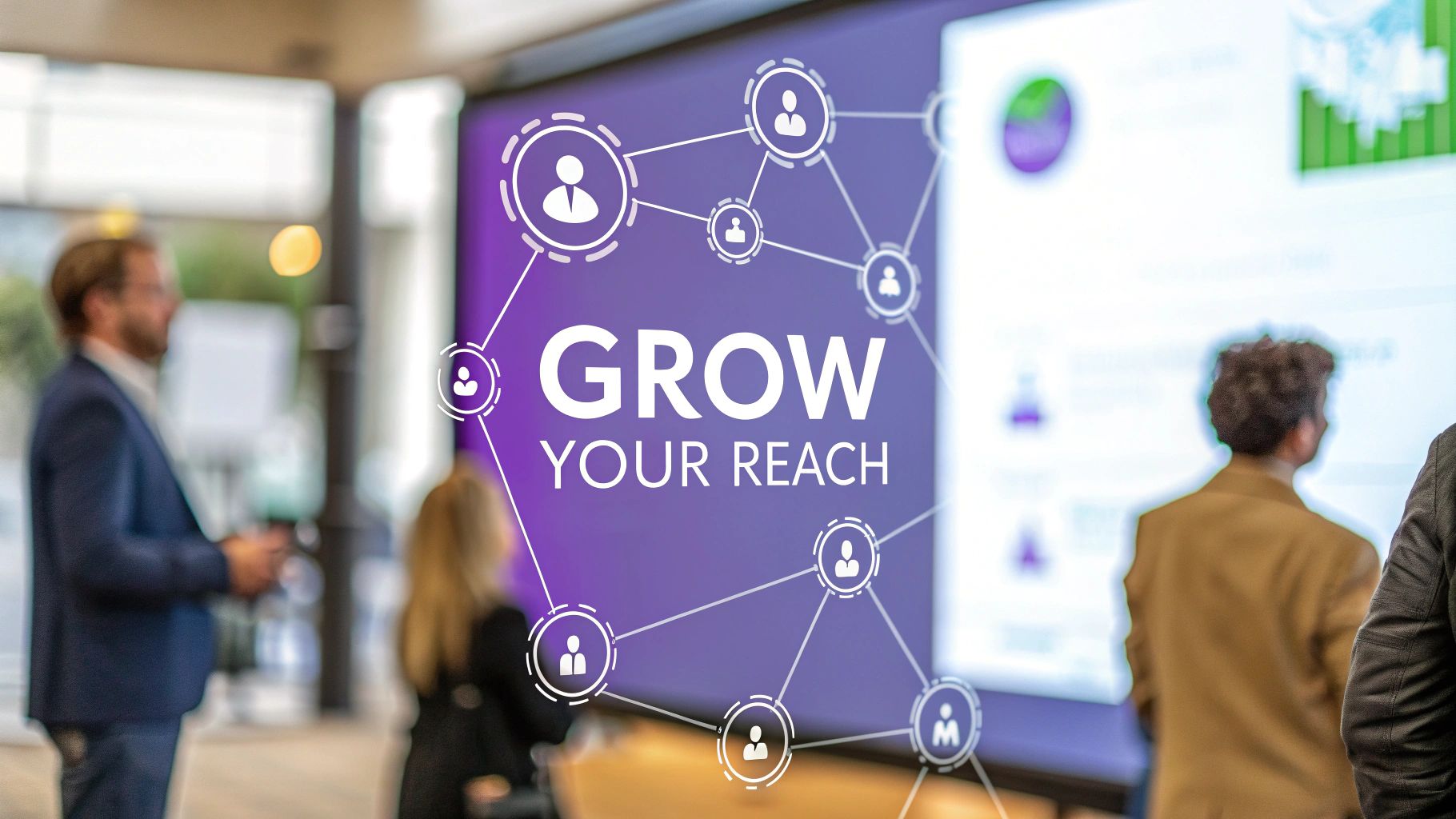Master Your Remote Work Job Search: Proven Strategies to Succeed
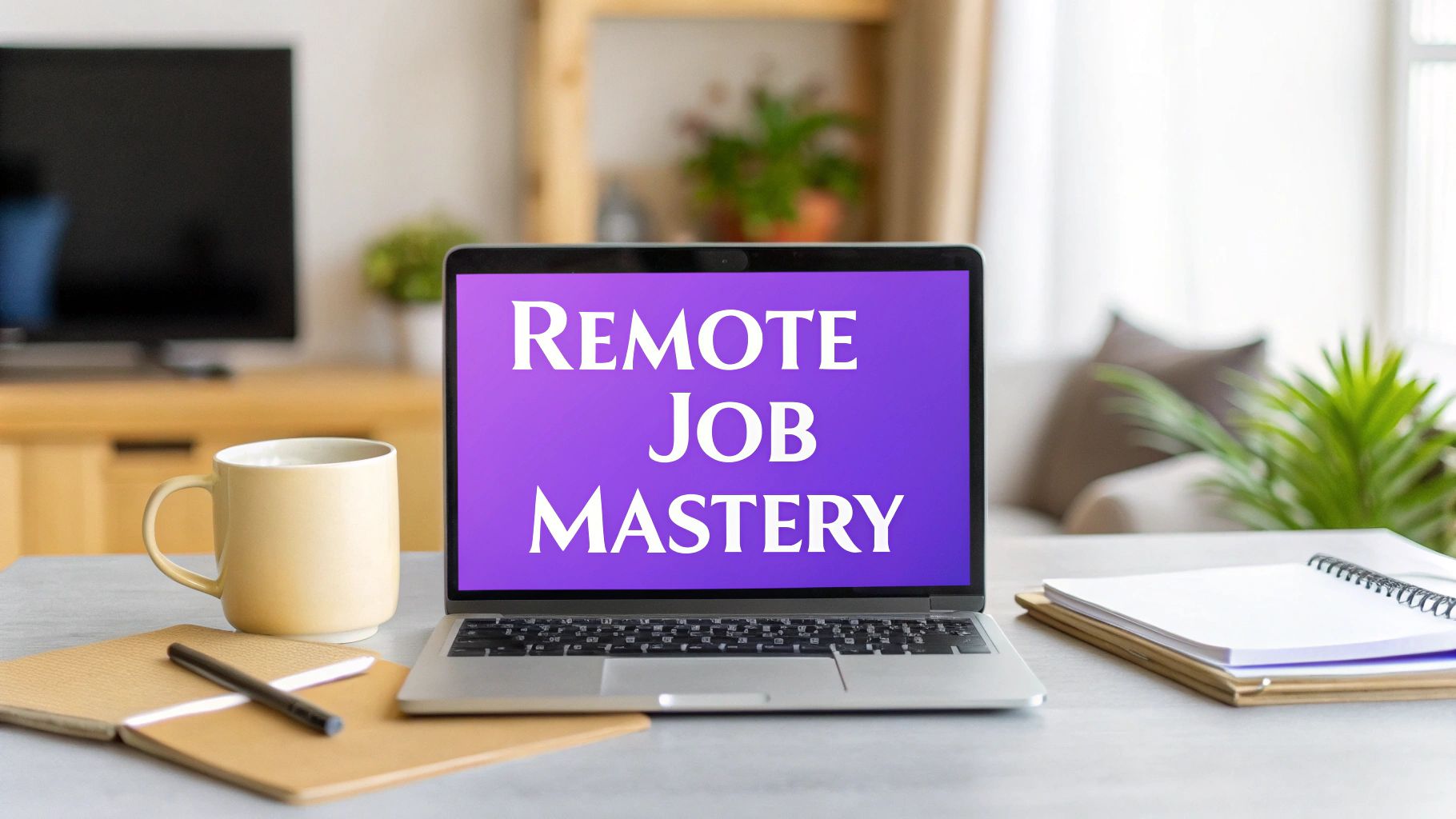
Finding a good remote job today is a whole different ballgame. If you're still thinking it's as easy as it was a few years ago, you're in for a rough ride. The reality is, it's now a fiercely competitive arena, and just "applying" isn't enough to get noticed.
Thriving in Today's Competitive Remote Job Market

The secret is out—everyone wants to work remotely. This has created a massive imbalance. While the number of remote-friendly companies has steadied, the flood of applicants for each role has exploded. It's not uncommon for a single opening to attract hundreds, if not thousands, of candidates.
The numbers don't lie. Current data shows that a staggering 60% of all job applications are for remote or hybrid positions. The catch? These roles only make up about 20% of the total job listings. That gap is where the competition gets intense, and it's why you need a smarter strategy.
Where to Focus Your Search
Let's be honest, not every industry has fully embraced the remote-first culture. You'll give yourself a much better shot by concentrating your efforts where the opportunities actually are. Sectors like tech, marketing, and professional services are still leading the charge.
As you navigate this market, it's also smart to keep an eye on broader industry shifts, like the potential impact of AI on job displacement, which will continue to shape what roles are available.
To get hired, you have to do more than just apply. Your goal should be to build a digital presence that screams, "I can get things done without someone looking over my shoulder."
This means your online profiles and application materials need to tell a story. A story of autonomy, digital savvy, and a proven track record of success. To learn more about building this kind of profile, check out our guide on how to enhance your online presence.
To help you target your search, we've broken down the sectors with the highest concentration of remote job postings.
Top Industries for Remote Job Opportunities
This table highlights the sectors with the highest percentage of remote job listings, helping you target your search effectively.
| Industry Sector | Percentage of Remote Jobs |
|---|---|
| Technology and IT | 18% |
| Marketing and Media | 14% |
| Professional and Business Services | 12% |
| Financial Services and Insurance | 10% |
| Healthcare (Non-Clinical Roles) | 9% |
By focusing on these high-opportunity industries, you can stop wasting time on long-shot applications and start putting your energy where it’s most likely to pay off.
Building a Professional Brand for Remote Work

When you’re going for a remote job, your online presence is the first—and often the only—impression a recruiter gets. There’s no firm handshake or sharp office attire to judge you by. All they see is your digital footprint.
This is about more than just filling out your LinkedIn profile. It’s about consciously building a brand that screams, "I can thrive without a manager hovering over my shoulder."
Your goal here is to show, not just tell. Instead of just saying you're a "great communicator," you need to frame your project descriptions to highlight how you used tools like Slack or Asana for asynchronous communication. It’s a small shift in language, but it makes a world of difference.
With remote jobs making up more than 15% of all opportunities by 2025—a threefold jump from pre-pandemic levels—a strong online brand isn’t just nice to have. It's essential.
Weaving Remote Skills into Your Story
Take a look back at your past projects, even the ones in a traditional office. How can you reframe them to spotlight remote-friendly skills? Everyone has moments where they worked with a high degree of independence—you just have to find them.
Here are a few examples to get you thinking:
- Project Management: Did you ever run a project with minimal oversight? Detail how you set your own deadlines and delivered results. That's proof you’re self-directed.
- Digital Collaboration: Did you coordinate with teammates in other departments or even other cities? Explain how you used digital tools to keep everyone aligned and informed.
- Problem-Solving: Think of a time you hit a wall and figured out a solution on your own before escalating. This shows initiative and resourcefulness.
This kind of strategic storytelling is the core of an effective online brand. If you want to dig deeper into this, our detailed guide on https://blog.makerbox.io/personal-branding-online offers even more insights.
Your LinkedIn summary isn't just a laundry list of skills; it's your professional narrative. Use it to tell a concise story about how you deliver value, no matter where you're working from.
Optimizing Your Digital Handshake
Think of your resume and LinkedIn profile as your digital handshake. They need to be firm, confident, and tailored for the remote job hunt. Recruiters are actively searching for keywords that signal you’re ready for remote work, and there's a lot of great advice out there on optimizing your LinkedIn profile for remote roles.
Make sure your profile is sprinkled with terms that remote-first companies are looking for. Put yourself in the hiring manager’s shoes and give them the exact skills and keywords they need to see.
How to Find and Vet High-Quality Remote Jobs
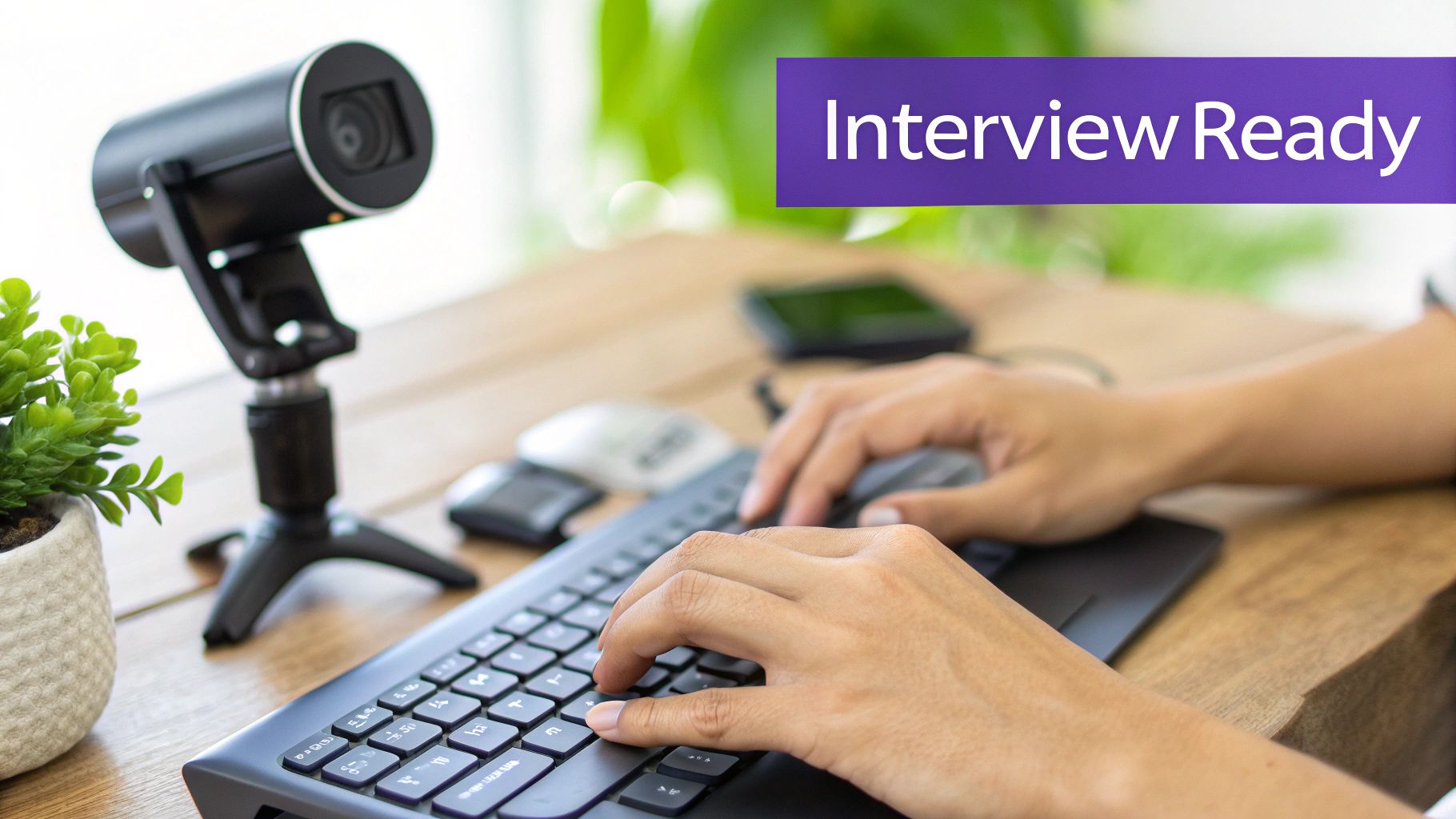
Mindlessly scrolling through huge, generic job boards is one of the quickest ways to burn out during a remote job search. A much smarter move is to stop casting a wide net and start fishing in the right ponds. That means shifting your focus to platforms built specifically for remote professionals.
When you kick off your remote job hunt, finding the best resources is everything. Niche job boards cut through the noise, connecting you directly with companies that have already embraced a remote-first culture. For instance, if you're in a specialized field like Web3, exploring the top platforms for crypto jobs remote can uncover relevant opportunities you’d probably miss otherwise.
Finding the Right Fit Beyond the Job Board
Once a promising role catches your eye, the real work begins. You need to vet the company just as much as they're vetting you. Is the company truly remote-first, or are they just "remote-friendly"? The difference is massive and will directly shape your day-to-day work life and career path.
A remote-first company builds its entire culture around a distributed workforce. They prioritize asynchronous communication, maintain excellent documentation, and offer equal opportunities for advancement, no matter where you're located.
A "remote-friendly" company might let you work from home, but its core processes and culture still revolve around a central office. This can lead to feeling disconnected or being passed over for opportunities.
Your Remote-First Vetting Checklist
As you comb through job descriptions and company career pages, keep an eye out for specific clues that point to a healthy remote culture. These signals tell you a company is actually set up to help you thrive from anywhere.
Here are the key things to look for:
- Asynchronous Mindset: Do they mention tools like Slack, Notion, or Asana? Do they talk about "asynchronous communication" or protecting "deep work" time? These are fantastic signs.
- Clear Documentation: Do they have a public company handbook or detailed "About Us" pages? Transparency is a hallmark of strong remote teams.
- Global Language: Do they mention specific time zones, or do they just say "work from anywhere"? Truly global companies tend to be more flexible.
- Remote-Specific Benefits: Look for perks like a home office stipend, a co-working space membership, or wellness allowances.
Finding a company that has truly mastered its remote operations is a game-changer. Research shows that employees in well-structured remote environments are significantly more productive, with some reports indicating a 35% to 40% increase in output. You can read the full research about these productivity findings to see why a strong remote culture is a win for both you and the employer.
Using AI to Accelerate Your Application Process
Applying for remote work is a numbers game, but it's also a quality game. You have to send out enough applications to get noticed, yet each one needs to feel personal enough to actually stand out. This is where AI tools can be your secret weapon, helping you handle the volume without sacrificing that crucial custom touch.
Let’s be real: the modern job hunt, especially for remote roles, often means getting past automated Applicant Tracking Systems (ATS) before a human even lays eyes on your resume. AI can be a powerful ally in that fight.
Tailoring Resumes and Cover Letters at Scale
Think of AI as your personal application assistant. You can drop a job description into a tool and ask it to pull out the most important keywords and skills. From there, you can prompt it to help you tweak the bullet points on your resume to mirror that exact language, which seriously boosts your odds of making it through the initial screening.
The same idea applies to cover letters. Instead of staring at a blank page for every single application, you can generate a solid first draft that pulls key details from both your resume and the job ad. Your role then becomes refining it—injecting your personality, sharing unique stories, and making it truly yours.
The goal is to let AI handle the 80% of repetitive work in your applications. That frees you up to pour your energy into the 20% that requires your human insight and genuine personalization.
This infographic breaks down the typical remote job application journey.

As you can see, customizing your application is a make-or-break step in the middle of the process. This is precisely where AI gives you the biggest advantage in speed and efficiency. Platforms like MakerBox are built specifically to streamline this customization. You can even check out a curated list of the best AI tools for job seekers to find the one that fits your workflow.
Preparing for the Interview Stage
AI’s usefulness doesn’t stop once your application is submitted. You can lean on it to get ready for those all-important video interviews.
It’s simple: feed the job description to an AI chatbot and ask it to act as an interviewer. It will generate a list of likely questions based on the role. Running through these mock sessions is an incredible way to sharpen your answers, calm your nerves, and build the confidence you need to shine when it’s time for the real conversation.
Mastering the Remote Interview Process
The video interview is your final exam in the remote job hunt. It's more than just a conversation; it’s a performance where you prove you can communicate clearly and thrive independently, all without ever stepping into an office. Getting this right boils down to solid preparation and showing you're truly remote-ready.
Of course, the basics have to be flawless. Good lighting, a clean background, and a stable internet connection are non-negotiable. But the real art is building rapport and projecting confidence through a screen. You can’t rely on a firm handshake, so your body language and tone of voice have to do all the heavy lifting.
Projecting Confidence and Engagement
Seasoned remote workers know how to make a digital connection feel real. They make deliberate eye contact by looking at the camera, not just at the person on the screen. They also use active listening cues, like nodding or briefly summarizing what the interviewer says, to show they’re completely tuned in.
This is your chance to shine. Frame every answer to highlight how you handle the unique demands of remote work.
- When asked about teamwork: Don't just talk about collaboration. Mention specific tools you’ve used for asynchronous updates, like drafting detailed project summaries in Notion or managing clear tickets in Jira.
- When asked about your work style: Emphasize your knack for managing your own schedule and proactively communicating progress. Show them you don't need constant check-ins to stay on track.
This approach demonstrates that you’ve already adopted the mindset of a successful remote employee. Your ability to articulate these skills is just as important as having them. Speaking of which, since your digital presence is their first impression, make sure you know how to optimize your LinkedIn profile so it strongly backs up your interview performance.
The best remote candidates don't just answer questions; they demonstrate their remote competence in every response. They show they understand the nuances of distributed teams.
Following Up and Negotiating
Once the call ends, a prompt and personalized thank-you email is crucial. Don't just send a generic template. Reference a specific, interesting point from your conversation to jog their memory and make your message stand out.
If an offer comes through, remember that remote work has its own unique set of negotiable perks. Don’t be shy about discussing things like a home office stipend, a budget for co-working spaces, or flexible hours that align with your most productive times. This signals that you’re a serious professional who is planning for long-term success in the role.
Your Remote Job Search Questions Answered
Diving into a remote job search can feel like a whole new world, and it’s natural for some unique questions to come up. Getting straight, practical answers is the key to spending your energy wisely and moving forward with confidence. Let's tackle some of the most common hurdles people face.
How Can I Stand Out When Hundreds Apply?
When you see a single remote role pull in hundreds, sometimes thousands, of applicants, it's easy to feel discouraged. But this is where quality completely smokes quantity. Your job isn't just to apply; it's to make sure you're not just another resume in the digital pile. That means carefully tailoring your application with keywords and phrases you pull directly from the job description.
But don't stop there. Before you even hit "apply," try finding a recruiter or a team member from the company on LinkedIn. A short, polite message introducing yourself can turn you from a faceless applicant into a real person. In your application, focus on results that prove you're autonomous and a great communicator—these are the top traits hiring managers crave in remote employees. A powerful opening to your resume is a must. For more on that, you can learn how to write a compelling resume summary.
The goal isn't to apply to more jobs; it's to make each application unforgettable. A unique project, a killer portfolio piece, or an insightful comment about the company can be the thing that gets you noticed.
Are 'Fully Remote' Jobs Truly Anywhere?
This is a big one. Unfortunately, "fully remote" often comes with an asterisk. Many companies have location restrictions because of different time zones, tax laws, or other legal employment rules. It's really common to see job posts labeled "Remote (US Only)" or "Remote (CET)."
If a job description is vague on this point, don't hesitate to ask the recruiter about it early in the conversation. It's a smart question that saves everyone time. A truly "location-independent" or "global" role is much rarer, and companies usually make a point to advertise it that way.
What Is the Best Way to Gain Remote Experience?
If you're new to remote work, you might have more experience than you think. It's all about how you frame it. Go back through your work history and pinpoint projects where you:
- Worked independently with little to no direct supervision.
- Managed your own schedule and hit your deadlines.
- Used digital tools like Slack, Asana, or Zoom to collaborate with your team.
That’s all remote-adjacent experience, and it absolutely counts. If you want to add more direct proof, look into freelance projects on platforms like Upwork or Toptal. Even offering your skills to a nonprofit in a remote volunteer role can add a powerful, tangible line to your resume.
How Do I Show I Have the Right Home Office Setup?
You don’t need to show off a fancy, executive-style home office, but you do need to signal that you’re a pro. When you're on a video interview, the first step is making sure your background is clean, quiet, and free of any distractions. No one wants to see a pile of laundry or hear a barking dog.
Be proactive about it. Mention in the interview that you have a dedicated workspace and a reliable, high-speed internet connection. This simple statement shows the interviewer you’ve already thought through the logistics of working from home and are ready to be productive from day one.
Ready to build a professional brand that gets you noticed in your remote work job search? With MakerBox, you can create optimized social media profiles and content that highlight your skills and attract top recruiters. Transform your online presence in seconds at https://www.makerbox.io.
